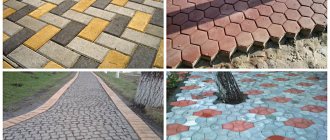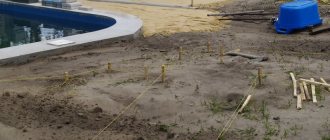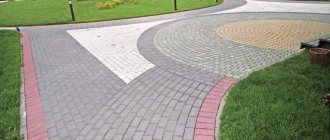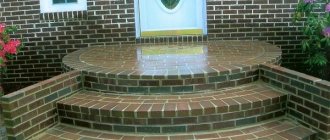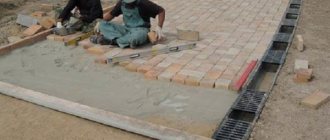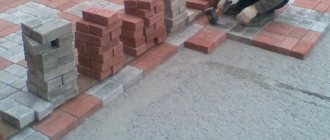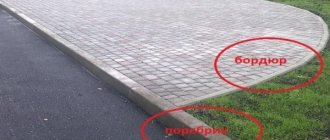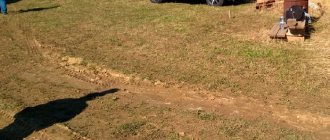Types and recommendations for selection
The question of choice is most often based only on the financial capabilities of the owner of the site, since good paving slabs are expensive, and cheap ones are short-lived and not very beautiful. The modern building materials market offers a classification of its main types according to the raw materials, that is, made from:
- natural hard rock;
- natural stone of soft rocks such as sandstone or flagstone;
- artificial stone;
- ceramics and other firing materials;
- colored and monochrome concrete;
- polymer sand mixtures.
Most often, individual developers purchase tiles made from colored concrete mixtures. This material is affordable and sold in almost any hardware store.
High-quality colored concrete tiles are made by vibration casting or vibration pressing. Piece products made by vibration casting are distinguished by bright colors and a smoother surface. Vibration-pressed material is more durable and frost-resistant, but not as bright.
Stamped tiles are also sometimes offered. Be very careful when purchasing it, as it is most likely a low-quality material made in an artisanal way.
A very important issue is the thickness of the material, which you must decide on before laying paving slabs with your own hands. For pedestrian paths on a personal plot, a thickness of 40 mm is recommended, and for a car park - at least 60 mm.
If you decide to pave the sidewalk on the street along your site, then use 60 mm tiles, and for the road (but this will be too noble on your part) you need to take 80 mm thick products.
Which tile to choose
Piece elements for laying paving slabs differ in price, quality of raw materials, shape, and color. To make the right choice, all criteria must be taken into account.
One of the first positions is the material from which the tiles are made. Modern production uses several varieties:
- natural hard rock;
- natural soft stone;
- fake diamond;
- ceramic material;
- concrete solution;
- rubber polymers;
- clinker material;
- polymer sand mixtures.
The most durable and durable options are natural stones and clinker. In second place in this parameter are less expensive analogues made of concrete and polymer-sand mixture. Rubber and plastic stones have the shortest shelf life. This is the cheapest tile, it is more suitable for those places that experience virtually no mechanical stress.
Before laying tiles, you need to decide not only its composition, but also its thickness. Blocks for narrow paths, patios, courtyards with light loads can have a thickness of 04.-0.6 cm. For areas where parking is planned, this parameter should be 0.8 cm. From an aesthetic point of view, the shape of the tile and its color are important . The pattern on the coating depends on this. For paving, blocks of rectangular, square, hexagonal, and figured shapes are used.
To lay tiles in one area, it is necessary to purchase material from one batch. This will eliminate discrepancies in shade.
Materials required for installation
Before laying paving slabs with your own hands, in addition to it, you need to purchase such materials as:
- stone or plastic border;
- cement grade PC400;
- crushed stone, fractions no more than 40 mm;
- sand, preferably river or washed;
- geotextiles.
The required amount of these building materials is determined separately and directly depends on the base design, type of soil and expected operating conditions.
Which one to choose: review of ready-made mixtures with prices
The best choice is usually a standard commercially prepared dry mix. After all, the main difference between a high-quality concrete mixture is a clear balance of the number of components, ensuring the necessary grade of all components and the environmental safety of the material, since today all building materials produced industrially are subject to the strictest control. Almost all large manufacturing companies have international certificates.
How to lay paving slabs on a concrete base is described here.
The best ready-made dry mixes consist of the following components:
- Crushed granite fraction from 5 mm to 10 mm.
- Sand, fineness modulus not less than coefficient 2.
- Portland cement, preferably grade M-500.
It is possible that you will be interested in material about preparing plasticizer for paving slabs with your own hands.
These are the main components that determine the quality and quality of the dry mix, and therefore the reliability of the tile path. Today, experts prefer universal dry mixes, which are used not only for laying tiles, but also in other construction and finishing works.
The most popular mixtures are:
- Kreisel mixtures for $32. USA per pack of 20 kg.
- Series of mixtures BIRSS, Russia, $1.0 each. USA packaging 25 kg.
- "Vetonit M" 100/600, Finland. Price from 1.0 to 1.75 dollars. USA, package 25 kg.
- PETROLITE price category from 0.85 to 1.55 dollars. USA, 25 kg per bag.
Having a plan for creating a unique path design or decorating a local area, you need to accurately study all the details of the technological methods for laying tiles. Having decided on creating a base from dry mixtures, you need to find out all the positive and negative aspects of this composite material, the features of the composition of industrial mixtures and the price of the quantity you need.
Marking future paths
It is recommended to take a copy of the site plan with buildings, trees, flower beds and other landscaping elements marked on it. Draw a diagram on it. This will be the instructions for laying paving slabs, which you will continue to work on. When drawing up such a scheme, the direction of the slopes should be taken into account for the free flow of water from the paths.
When deciding on the width of the paths, it is necessary to ensure that 2 people can easily separate on it. Typically this value is 1.0 - 1.2 meters.
In the case of a car passing, the possibility of a person being present is also taken into account, who should not be forced to leave the paved surface.
Marking and excavation of soil.
The marking is carried out according to the drawn up plan using a tape measure and a cord, which is pulled along the pegs hammered along the planned path. When pulling the cord, it is necessary to add 10 cm to the width of the path on each side, with a gap for the subsequent installation of curbs.
Excavation and protective layer
The volume of work performed depends on the density of the top layer.
If the surface is dense clay or any other similar soil, and therefore it is planned to import bulk soil, then preparing the path for laying tiles comes down to simply leveling the surface. In all other cases, it is necessary to remove 30-35 cm of the surface layer along the entire marked perimeter.
It is necessary to add a thin leveling layer of sand to the bottom of the trench and compact it well along with the soil. This underlying layer will then need to be covered with geotextiles, which will prevent the germination of weeds, allow water to be drained from the drainage layer and prevent the penetration of groundwater rising in the spring.
The geotextile strips are laid out in such a way that adjacent sheets overlap by 15-20 cm, and at the edges of the trench there is an upturn of at least 20 cm. In this case, the technology for laying paving slabs with your own hands will be fully followed, and the result of your work will be incomparably better quality .
Why do you need a slope when laying paving slabs?
The slope when laying paving slabs and paving stones allows for good water drainage during rains or snow melting. If it is done correctly, moisture will not be retained and will not penetrate into the material. The absence of a slope or its incorrect determination will lead to the appearance of puddles that will destroy the waterproofness of the paving stones, which will cause the destruction of the coating.
The minimum slope of paving slabs per 1 meter of pavement width should be 1 cm. As is usually expressed as a percentage, then 1 cm = 1%. In order to ensure good water flow, 1% is enough. In addition, 1% will not prevent pedestrians, people with strollers or people in wheelchairs from moving comfortably along the path.
The percentage depends on the climate and characteristics of the area where it is planned to lay the tile material. You should also consider the type of tile itself - smooth or textured. Relief products are more difficult to drain water, so the slope for them should be greater. For example, if a slope of 2% is made for smooth paving stones, then for embossed paving stones this value should be increased to 2.5%.
Drainage device
A layer of crushed stone 15-18 cm thick is poured onto the compacted bottom of the trench, lined with geotextile. It will serve as drainage for collecting and discharging melt and surface water. The presence of a drainage layer will prevent possible accumulation of moisture at the base of the path and subsequent swelling if the soil freezes.
The crushed stone should be compacted well and sprinkled with a thin layer of sand. A second layer of geotextile should be laid over the drainage. It will allow moisture to pass down, preventing it from returning.
Stone products are fixed with mortar, and plastic ones are fixed using the wedges included in their delivery.
Placement of boundary borders
At the next stage of work, curbs are installed. For this you can use almost any materials. External fencing of paths is made of stone, concrete, plastic, brick, wood, slate and any other flat materials.
The traditional option is a ready-made concrete curb. Recently, manufacturers have offered several types of plastic borders on the market, which are characterized by durability, low cost and ease of installation.
The border is installed after the installation of the drainage layer.
Types of bases used
To install pedestrian paths on the site, one of three possible types of support base is used:
- concrete;
- cement-sand;
- from compacted sand.
Concrete foundation is the most expensive, and therefore it is advisable to use it only in case of expected large loads on the surface. The cement-sand base is the most common and versatile. A sandy base can be used with low surface loads and the absence of heaving soils and their movements.
Schematic illustration of a concrete base.
Pouring the concrete base
Work on concreting the base, before laying paving slabs, begins with reinforcement. To do this, it is best to use a ready-made welded metal mesh with a cell size of 100x100 mm. If you have remnants of old metal pipes, wire, rods more than 5 mm thick or other similar metal remnants, then reinforcement can be done using them.
To do this, lay out the metal in the form of a lattice and tie its individual parts at the intersections with wire. It is advisable to raise the reinforcing mesh above the surface by 3-5 cm, placing it on metal or stone stands.
The concrete layer should be 10-12 cm thick, and its surface should be below the surface of the earth by the thickness of the tile minus 3 cm, since we will then have to lay the paving slabs here with our own hands.
If after installing the drainage layer the depth of the working trench remains quite large, then the excess is covered with sand, which is then compacted. Concrete mixture using PC400 cement is prepared in a volumetric ratio of cement, sand and crushed stone as 1:3:5.
Paving slabs
| ! | Please write comments and additions in the comments | ! |
Paving slabs look much better in the yard than asphalt. It is “repairable” - if you need to install, for example, a pipe or cable, then the tile can be disassembled and then put back.
The tiles on the site are used for paving areas and paths. In Russia, the most popular tiles are made of concrete, although there are tiles made of natural stone and ceramic tiles made of clinker clay.
Types of concrete tiles
Concrete paving slabs are made from a mixture of cement, aggregate and water. To produce tiles, manufacturers pour the concrete mixture into molds and then they can press it, vibrate it, or do nothing and just wait for it to harden. Accordingly, concrete tiles can be divided into molded (stamped), vibration-cast and vibration-pressed.
If the concrete mixture has not been vibrated or pressed, it is usually the worst tile. Vibro-cast is better than molded stamping; it froze in molds while on a vibrating surface. Vibro-pressed tiles are better than vibro-cast tiles; they were pressed while lying on a vibrating surface. Pressing is necessary to compact the concrete mixture.
Tile thickness
For reliability, it is better to take concrete tiles with a thickness of 40 mm; if the thickness is less, then the risks of cracking increase. Concrete tiles 60 mm thick are suitable for driving cars.
Tile slope
The slope of the tiles is needed to drain rain and melt water. The slope is usually indicated as a percentage (not to be confused with degrees), a slope of 1% is 0.01 m per 1 m, i.e. 1 centimeter by 1 meter. On the Internet they often write a recommended slope of 1%, but some manufacturers recommend a slope of 2%. The greater the angle, the better the water will drain, but tiles with too high a slope are uncomfortable to walk on.
Significant slope of the tiles
There is also an opinion that horizontally laid tiles lie more securely than tiles on an inclined surface. Therefore, instead of an angle of, for example, 20 degrees, it is better to make a step and two flat surfaces (but not forgetting about the minimum slope for drainage). But not everyone loves steps and I have seen sloped surfaces tiled 10 years ago doing just fine.
Laying paving slabs
1. You need to draw up a paving plan, think about where and how the drainage will go across the entire surface. 2. Next, remove the soil to the required depth (15-25 cm). Level and tamp the resulting surface. 3. We dig ditches for side stones (i.e. curbs). We fill in crushed stone and install curbs on top of the cement mortar. 4. Pour a layer of crushed stone of fraction 5-20 mm with a thickness of 10-20 cm onto the ground. Compact it. 5. Pour sand 5 cm thick. Compact. 6. Pour a dry mixture of sand and cement 10:1, which will be the base for the tiles. 7. Lay the tiles. We tamp with a vibrating plate. 8. Difficult areas (for example, bypassing a round sewer manhole) can be completed at the end, when the main part of the installation work is completed. 9. Fill the gaps between the tiles with sand.
Some people, trying to reduce costs, do not use crushed stone due to its high cost compared to sand. However, crushed stone is a non-heaving building material; therefore, when used, the risks of winter heaving are reduced.
Adviсe
The soil is below the tile, the curb is below the tile. Click on the photo to enlarge.
The ground level should always be below the level of the tiles. Then the dirt will not drain from the ground, and water, on the contrary, will flow from the tiles into the ground. Therefore, the border should also not be higher than the level of the tiles; I drew this schematically on the right. Moreover, I recommend making the border a couple of centimeters below the level of the tiles, because... Over the years, the tiles may sag a little, but the border will remain in place and create a barrier for water.
| I will be glad to see your comments on the topic of the article and any additions. Remember, the author is an ordinary person, I don’t always have time to answer if you ask a question about your construction project. |
| Marina (06.10.2014 09:16) Hello! Please tell me what one large tile step should look like, suitable for the foundation of the house? Our installers installed a curb with, in my opinion, a large slope of 4 m - 7 cm, and visually this slant from right to left is very noticeable against the background of the foundation horizon. Maybe they did something wrong? Thank you! |
| Peter (11/10/2014 15:28) You can lay tiles using this technology. It will last for 3...4 years, and later it will “float”. Tiles “with a lifetime guarantee” are laid a little differently and this is a very labor-intensive process. |
| Andrey (07/12/2016 20:52) I recommend laying geotextiles on the ground when laying paving slabs. Geotextiles promote uniform load distribution and improve work quality. |
| Alexey (12/30/2016 11:07) The use of geotextiles is a must. It prevents sand from being washed away into the porous layer of crushed stone. Reduces the likelihood of failures. |
Treating tiles before laying
Before laying paving slabs yourself, it is recommended to treat them with a hydrophobic compound, which will further protect the material from moisture and increase its frost resistance and durability. In addition, water repellents give the tiles a more attractive appearance and prevent the appearance of fungus, mold and salt stains on the surface.
To process the tile, it is dipped into a hydrophobic solution, dried and this operation is repeated. During pre-processing, the tiles must be carefully inspected and all products containing defects must be put aside, since we will then lay them out in other, inconspicuous areas.
